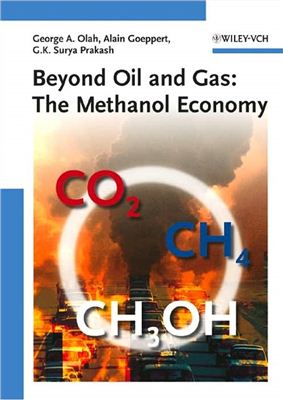Wiley-VCH. 2006. 304p
In this masterpiece, the renowned chemistry Nobel Laureate, George A. Olah and his colleagues discuss in a clear and readily accessible manner the use of methanol as a viable alteative to our diminishing fossil fuel resources. They look at the pros and cons of our current main energy sources, namely oil and natural gas, and varied renewable energies, and new ways to overcome obstacles.
Following an introduction, Olah, Goeppert and Prakash look at the interrelation of fuels and energy, and at the extent of our non-renewable fossil fuel resources. Despite the diminishing reserve and global warming, the authors point out the continuing need for hydrocarbons and their products. They also discuss the envisioned hydrogen economy and its significant shortcomings. The main section then focuses on the methanol economy, including the conversion carbon dioxide from industrial exhausts (such as flue gases from fossil fuel buing power plants) and carbon dioxide contained in the atmoshere into convenient liquid methanol for fuel uses (notably in fuel cells) and as a raw material for hydrocarbons. The book is rounded off with a glimpse into the future.
A forward-looking and inspiring work regarding the major challenges of future energy and environmental problems.
In this masterpiece, the renowned chemistry Nobel Laureate, George A. Olah and his colleagues discuss in a clear and readily accessible manner the use of methanol as a viable alteative to our diminishing fossil fuel resources. They look at the pros and cons of our current main energy sources, namely oil and natural gas, and varied renewable energies, and new ways to overcome obstacles.
Following an introduction, Olah, Goeppert and Prakash look at the interrelation of fuels and energy, and at the extent of our non-renewable fossil fuel resources. Despite the diminishing reserve and global warming, the authors point out the continuing need for hydrocarbons and their products. They also discuss the envisioned hydrogen economy and its significant shortcomings. The main section then focuses on the methanol economy, including the conversion carbon dioxide from industrial exhausts (such as flue gases from fossil fuel buing power plants) and carbon dioxide contained in the atmoshere into convenient liquid methanol for fuel uses (notably in fuel cells) and as a raw material for hydrocarbons. The book is rounded off with a glimpse into the future.
A forward-looking and inspiring work regarding the major challenges of future energy and environmental problems.

